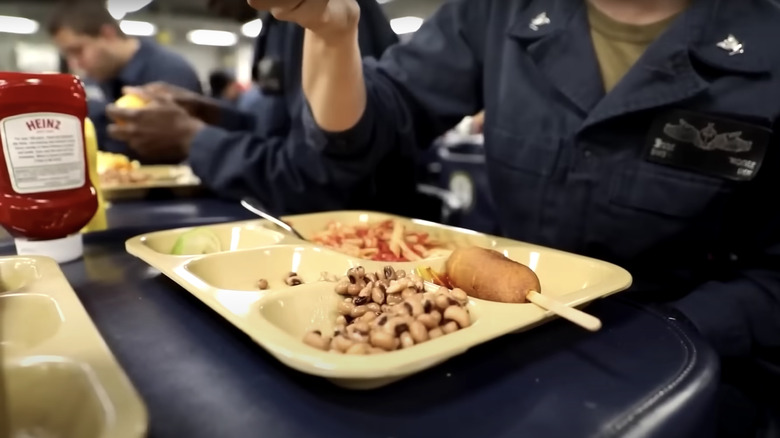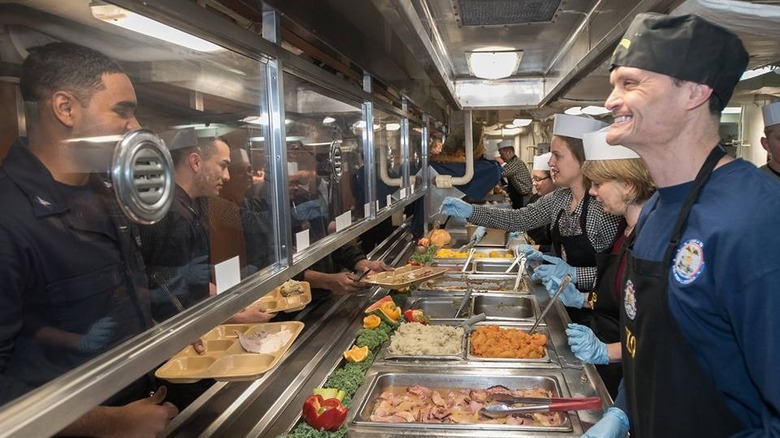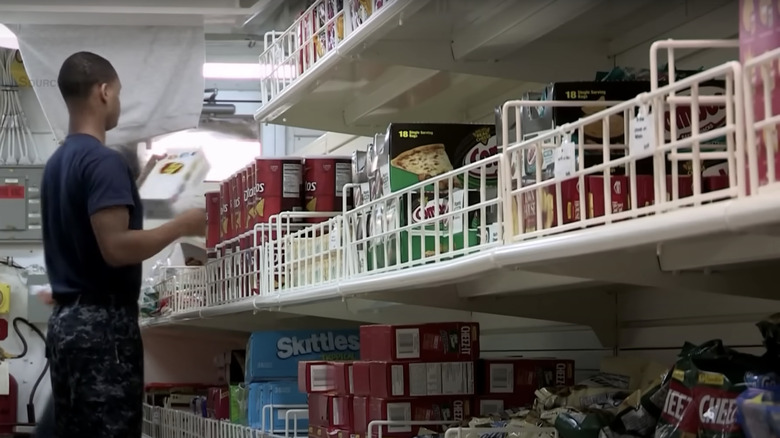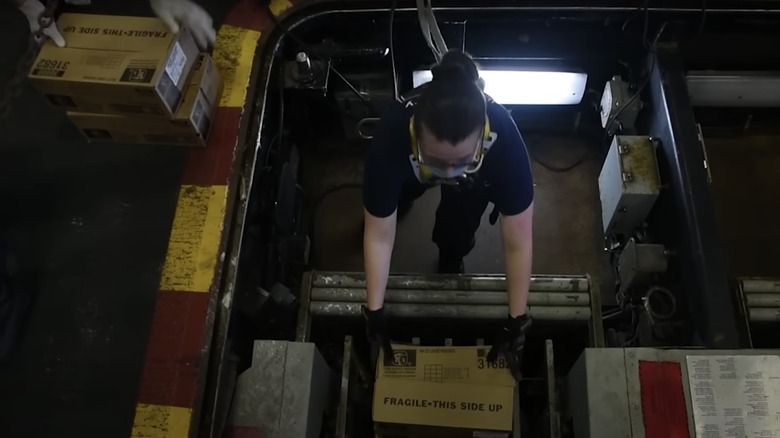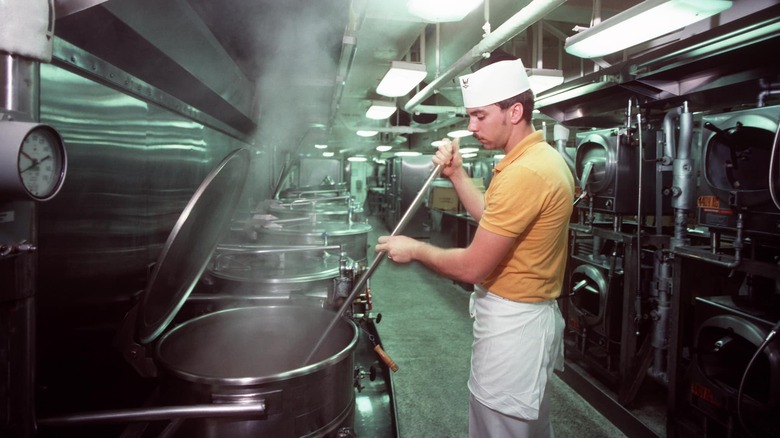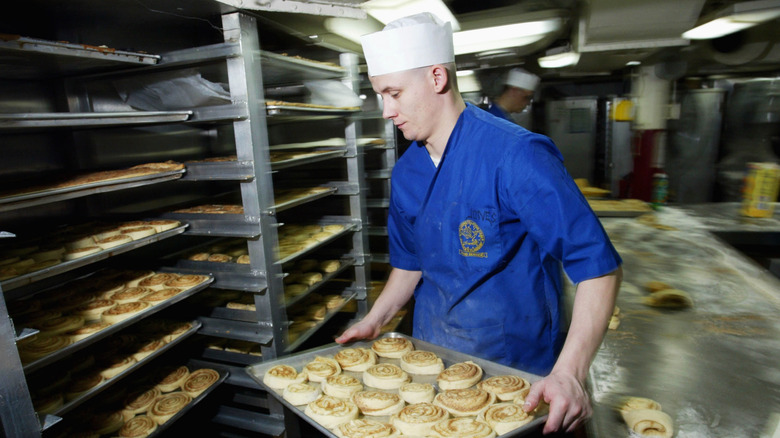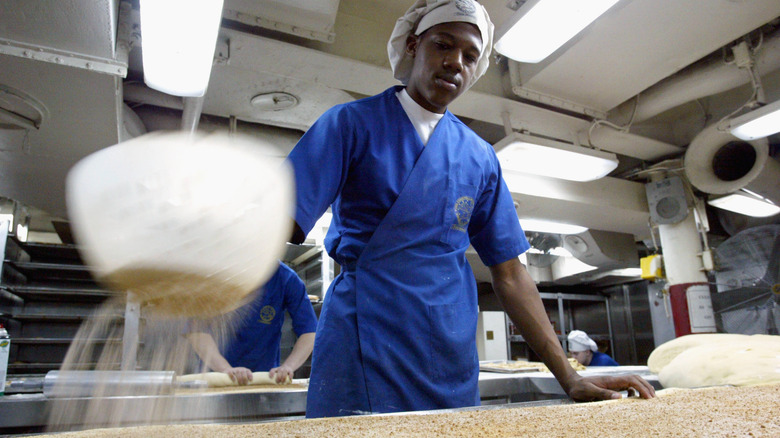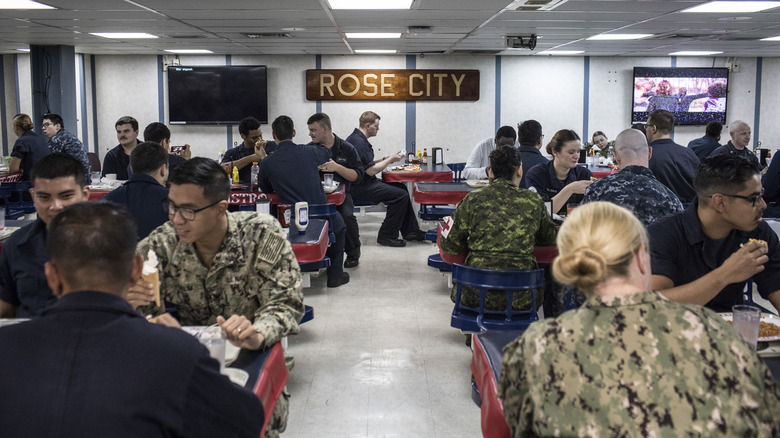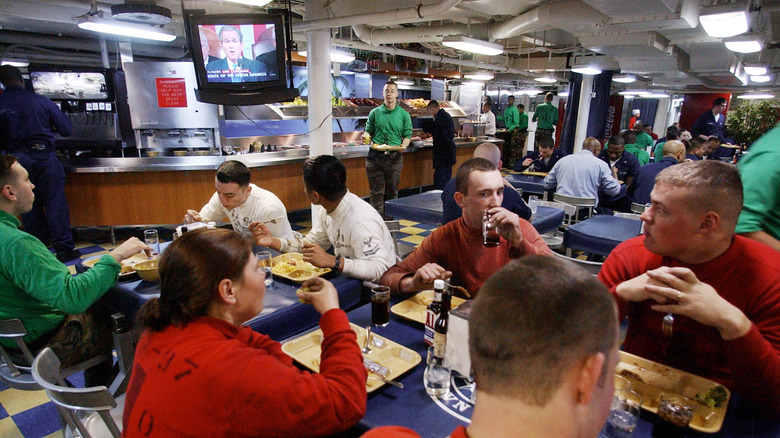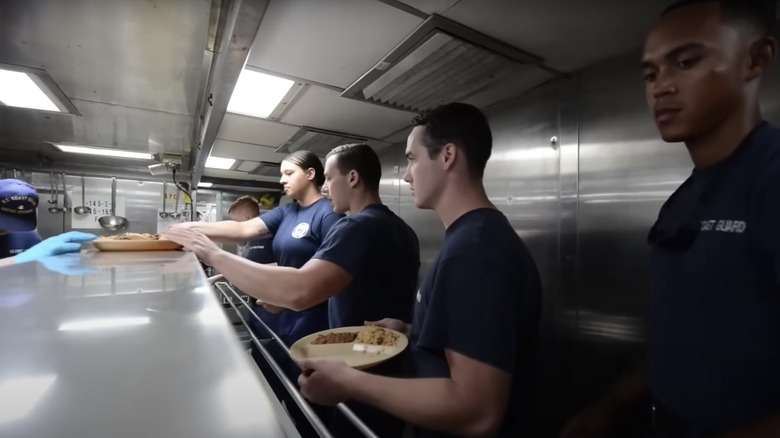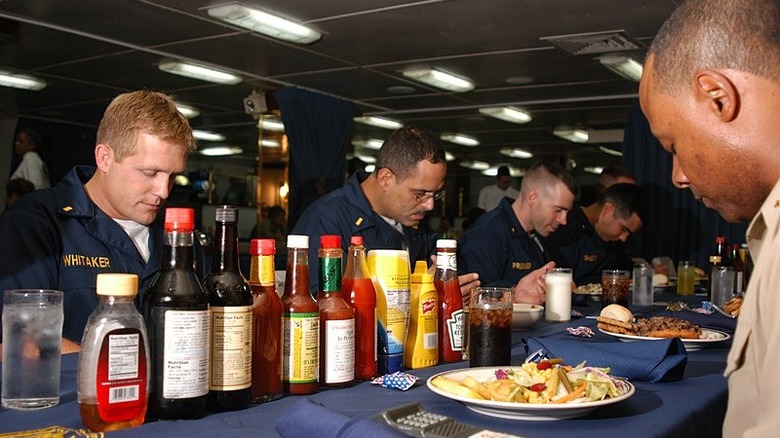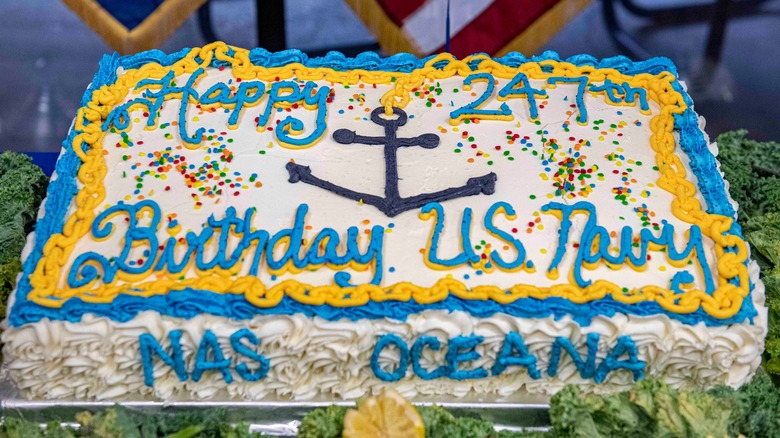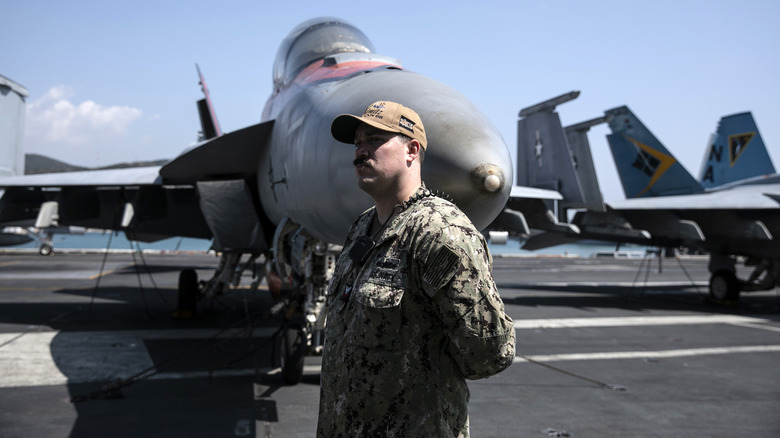What Cooking And Eating On A Navy Aircraft Carrier Is Really Like
Over the years and for generations, the United States has relied on its military to protect and serve its country in various capacities. While civilians enjoy dining out at restaurants in their local towns or in the comfort of their homes, the people on active duty have a distinctly different lifestyle. Eating and cooking aboard a Navy aircraft carrier is a unique experience that combines precision, efficiency, and a touch of ingenuity. The massive floating city must cater to thousands of crew members, ensuring their nutritional needs are met while operating in high-pressure environments. With limited space and resources, the ship's galley becomes a culinary hub where talented chefs orchestrate the production of thousands of meals each day.
From hearty comfort food to international delicacies, the cuisine aboard a Navy aircraft carrier aims to reflect the diverse needs of its diverse crew, providing sustenance that fuels their missions at sea. People with hefty appetites live aboard the monolithic vessels for anywhere from six to nine months at a time and require an understandably massive quantity of food to keep going. From food storage to meal planning to service style and more, the Navy aircraft carrier crews, chefs, and staff take on an unusually daunting task in the kitchen. While many of us may never go aboard to see for ourselves, here is a small glimpse into what cooking and eating aboard a Navy aircraft carrier is truly like.
Aircraft carrier chefs feed thousands
The impressive size of Navy aircraft carriers allows them to accommodate the heavy and powerful aircraft that they carry. If you've seen "Top Gun," then you have a good image of what these look like. In addition to the planes and jets, however, the aircraft carriers also need to host the masses of people who live aboard the giant vessels. On average, an aircraft carrier holds around 5,000-6,000 people, all of whom are working hard and entering the food line hungry.
This gives the carrier's kitchen crew the impressive task of preparing over 17,000 meals daily. The meals offer nutrition and fuel as well as comfort and satisfaction, which is a necessary morale booster when living at sea. Unsurprisingly, meals of this quantity are not magically made by just one chef (thank goodness). Instead, over 100 cooks and culinary specialists stay on board to cook and serve the food, which adheres to strict standards and plans. As is its intended purpose, the Navy aircraft carrier remains poised for action at any time, while the Navy aircraft kitchen crew works around the clock no matter what. This ensures that food is available all day and all night to keep the round-the-clock workers fed and strong.
The ship has massive grocery needs
Think back to the last time you went grocery shopping for a big party where you fed a crowd. Multiply your party-planning grocery list by several thousand to reach the level of responsibility that comes with shopping for thousands of hungry soldiers. With their round-the-clock meals and thousands of hungry people, the Navy aircraft carriers understandably demand impressive quantities of groceries to stay in production. A typical grocery trip for one of these carriers contains enough food to buy out any grocery store you've likely ever been to.
On average, to prepare the 17,000 meals per day, it takes anywhere from $45,000 to $65,000 per day of groceries. This includes over 1500 pounds of chicken to supply a main protein dish for each sailor. If they want to serve up a salad, they need at least 350 pounds of lettuce, not to mention things to go on the lettuce. For the necessity of life, aka coffee, the kitchen prepares 20,000 cups of coffee and around 160 gallons of milk for those who like milk with their brew. Furthermore, to offer cereal as a breakfast option, they need at least 30 boxes to support the 5,000 sailors that might partake. Other recipes from the Navy cookbook include cakes, gravies, and soups, each with its own hefty list of ingredients. Even the most generous person likely wouldn't dream of offering to swipe their card for a grocery order of this caliber.
The ships use special food preservation technology
Food storage aboard a Navy aircraft carrier is a well-organized system that ensures the crew's appetites are rewarded with fresh food and tasty ingredients that will please both palate and appetite. The carrier features refrigerated and dry food storage areas reminiscent of a commercial supermarket. These areas provide respite from the sweltering parts of the ship that lack air conditioning. Within the refrigeration compartments, fluorescent lights illuminate pallets full of vegetables, all kept fresh by a central refrigeration system. These rooms are also fitted with ethylene filters which help reduce the gasses that contribute to the over-ripening of produce. For the freezers, there is a thorough plan of unit-by-unit defrosting as needed to support the planned menu.
Supply personnel aims to restock provisions weekly, utilizing contracts with major wholesale distributors at various ports, where food is shuttled to the ship as it passes. However, when the carrier is far out at sea, the availability of fresh foods diminishes, making way for canned or dried alternatives. Multiple kitchens operate throughout the ship, with one particular highlight being the bakery, where freshly baked cookies evoke a sense of home and nostalgia. With prioritization of storing fresh foods to last as long as possible, the Navy carrier's food storage helps contribute to the crew's morale and productivity during long deployments at sea.
The galley is a sight to behold
Some Navy air carriers, like the USS George HW Bush, have multiple galleys or kitchens. Typically there is a main galley and supporting galleys, all of which contribute to daily food output quantity and quality. Taking a glimpse into one of these galleys will show you multiple pans of impressive size that can hold almost 80 gallons of food. In order to cook food for the masses while maintaining efficiency, there are huge basins that are used to steam the many bags of vegetables, a gigantic, child-sized dough mixer that can mix 60-pounds of dough for fresh bread, giant Jacuzzi-sized deep fryers, and commercial-sized ovens reminiscent of a Hansel and Gretel witch's trap. Additionally, the galleys boast expansive griddles and human-sized stand mixers.
At any given moment in the multiple galleys, you may find chefs lining up hundreds of cuts of meat onto the behemoth grill, from lamb chops to pork chops, chicken legs, and anything in between. Talk about multitasking because it is no easy feat to place over 100 pieces of meat on a grill, flip them on time, and ensure that they are all cooked thoroughly. A galley aboard a Navy aircraft carrier is home to a ceaseless flurry of activity, cooking, and preparation, all aiming to supply its sailors with tastes of home and fuel to fight the good fight.
Meal planning for the crew is no easy feat
Aboard the floating food-filled city of a Navy aircraft carrier, there are people who could rival Marie Kondo with their organization. Culinary specialists meticulously plan out the menu for thousands on a rotating schedule. These talented individuals hold the carrier's entire food production together and feed the 5,000-plus crew members while still abiding by nutritional guidelines and making satisfying meal offerings.
Supply ships bring the goods and ingredients to the carrier every week or two, typically dropping off 500,000 to one million pounds of food with every trip. From these pounds of culinary potential, the culinary specialists create a menu to span the next 21 days, all while trying to add creativity, homestyle flavors, and comfort amidst the necessity of nutrition and basic sustenance. Some specialists have curated meals like taco Tuesdays, regional dishes that give a taste of their surroundings at the time, and cultural-based food nights to include Asian fare, Greek fare, and any other fun meal plans they have the resources for. The Navy's culinary specialists must live and breathe food to keep ideas and productivity flowing for their sailors who eat around the clock.
Food allergies can make things complicated
It is no surprise that in a group of over 5,000 people, there is bound to be a food allergy or two. Thus, the aircraft carriers' chefs are tasked with keeping everyone fed and providing certain offerings for those that can't tolerate particular ingredients. The Navy does not prevent those with food allergies from joining the service and being deployed but does exercise caution with applicants with a history of intense allergic reactions. Each branch of the military handles food allergies in its own way.
For the Navy, allergies are handled case-by-case. Upon registering, the individual with the allergy will undergo a medical evaluation and may be granted a waiver to serve despite their history of allergies. If a sailor has an allergic reaction while serving and is later prescribed an EpiPen, they aren't usually discharged, but their allergy status may change the jobs they are allowed to do. Crew members can also select the foods they want from several options and can generally avoid problematic ingredients as needed.
Meal service is pleasant yet crowded
Service aboard a Navy aircraft carrier is comparable to a school cafeteria, with lengthy lines. On the ship, there are typically four meals a day to support its 24/7 operation. These meals consist of breakfast, lunch, dinner, and the intriguingly named "midrats" for midnight rations and the overnight crew, although the association with rodents is hopefully unfounded. For breakfast, the mess hall is open from 6 am to 9 am, offering various dishes with special options daily. Occasionally, they have special treats like donuts or sweet rolls, which tend to disappear quickly. First come, first serve is king. The breakfast line stretches throughout the ship, spanning across steep ladders (stairs aboard a Navy vessel), and ultimately leads to a menu board that the crew can assess while preparing to choose their order. Once they reach the line, they are given a cafeteria-style tray and silverware.
The sailors make their way through the line, tray in hand, and pick out what they want to fill it. Then, they reach the seating area, which varies based on rank. While chief officers have a nice dining room, the lower-ranked crew often find their seats in a cafeteria that resembles a crowded school-style lunchroom.
Dinner is served buffet style
The General Mess, where most crew members eat, offers a variety of options that could include mashed potatoes, steak with gravy, BBQ chicken, stir fry, or pasta with chicken and tomato sauce. All of these options are displayed on a long buffet and available for viewing and selection. While the masses enjoy food from the buffet, some officers dine in the refined Wardroom and enjoy a more elaborate setting with padded chairs, navy tablecloths, and attentive servers. They may also get perks like Friday brunch to create a relaxed atmosphere and something to look forward to.
In the Captain's Cabin, the Commanding Officer enjoys meals prepared by a chef who crafts menus to suit the occasion, incorporating dishes like confit duck and individual desserts with French influences. Food plays a significant role in maintaining morale onboard Navy aircraft carriers, and the culinary team strives to modify menus, organize themed events, and provide treats to keep spirits high. While the majority of service is in the style of a dining hall or buffet, the chefs still aim to impress.
The crew has limited food options
From World War II until today, the official Navy cookbook has emphasized nutrition and efficiency. It offers a reasonable range of food options for the crew and measurements and calculations for the chefs. Even so, the crew at sea is still somewhat limited in what they can eat or request by the ingredients on board. The Navy cookbook focuses on fresh ingredients and encourages the use of spices and a colorful assortment of food with each meal. The WWII-era cookbook even provides unique combinations to accommodate supply inconsistencies. Ingredients such as frozen eggs are one example that meets the nutritional requirements of the Department of the Navy and ensures that the crew receives balanced and nourishing meals, even in challenging circumstances.
While coffee is liquid gold on an aircraft, a few lucky vessels receive a step above the cafeteria-offered bean juice. The USS Carl Vinson is one such lucky venue, with an ever-coveted Starbucks location onboard. Known as Chucky's Cafe, the Starbucks with budget prices gives the sailors a caffeinated treat and taste of home to look forward to. To establish the validity of the shop, Starbucks representatives came to give their stamp of approval on the taste and quality of the coffee served.
The crew can get food 24/7
A Navy aircraft carrier never sleeps, and there is a constant buzzing of working crew members at all hours of the day and night. With varying schedules and limited space, not everyone can eat at the same meal times, so meals are offered on a rotating basis 24/7. As mentioned above, the standard breakfast, lunch, dinner, and midrats offerings keep food flowing at all hours and keep the kitchen as busy as possible.
While the first three meals of the day may abide by a pre-planned menu, the midrats offerings can be a bit more eclectic. Usually a mix of leftovers from previous meals with a few fresh surprises thrown in, midrats allows late-night eaters to refuel after or before their night shift onboard. Every crew member receives a food budget or allowance. While crew aboard ship use this allowance in the mess hall, sailors not currently stationed on a ship can use it to purchase food anywhere.
The carrier celebrates special holidays and events
If you've ever had a working birthday and received a cake from your coworkers, that probably added a nice touch to your big day. Perhaps it is comforting to know that sailors aboard the Navy aircraft carriers out there are also afforded a similar treat. With over 5,000 people come over 5,000 birthdays, and the kitchen aims to cater to them all in a small but special way.
Each calendar month, those with birthdays receive a special monthly treat meal, including an elegant white tablecloth, wine glasses, a smidge of atmosphere with some music, and a more gourmet than usual entree like lobster or prime rib. When you're stuck living in a floating city with the same walls around you every day, food is sometimes the best way to shake up your routine and add a little pizazz. As Chief Petty Officer Naomi Goodwyn told Stars and Stripes, "Everything in life is surrounded by food."
The crew stays ready for action, no matter what
While food is served nonstop, the ultimate purpose of a Navy aircraft carrier doesn't stop because it's mealtime. Throughout all of the meals, cooking, prep work, and birthdays, the carrier still must, above all, be ready for action. In addition to training the combat personnel, the kitchen crew is trained as well and knows how to respond when chaos strikes. Every person has their station and reports to it when they hear the call.
Like most military branches, teamwork makes the dream work and is a crucial foundation for any successful operation. With plenty of training drills, practice makes perfect and is necessary for the ever-growing crew. In some cases, new sailors can arrive every day and need training from the ground up. Furthermore, the constant threat of interruption can leave sailors without their regularly scheduled meals. As one ex-Navy soldier on Reddit said it can be challenging when you're in line for grub and have to leave for an emergency call. Because of your shift schedule, you may end up waiting another seven hours to get food again.
Waste management turns into ocean decor
It should come as no surprise that the quantity of food and people leads to a hefty amount of waste. From cooking to serving to eating, waste is an unavoidable part of life aboard a Navy aircraft carrier, and unfortunately, it goes exactly where you might have guessed.
According to a previous sailor on the USS George Washington, almost everything gets dumped directly into the ocean (via Cracked). He specified that almost everything gets thrown overboard, except for plastic (although we don't know that anyone is truly regulating that). He explained that most of the ship's waste is food waste and paper, which goes through a paper pulping machine to make it easier to dissolve. Otherwise, there are reports of people throwing anything and everything into the sea, including broken printers and silverware. It may make you think about the next sand you step foot onto. It could very well be the broken-down trash of Navy aircraft carriers from the past.
